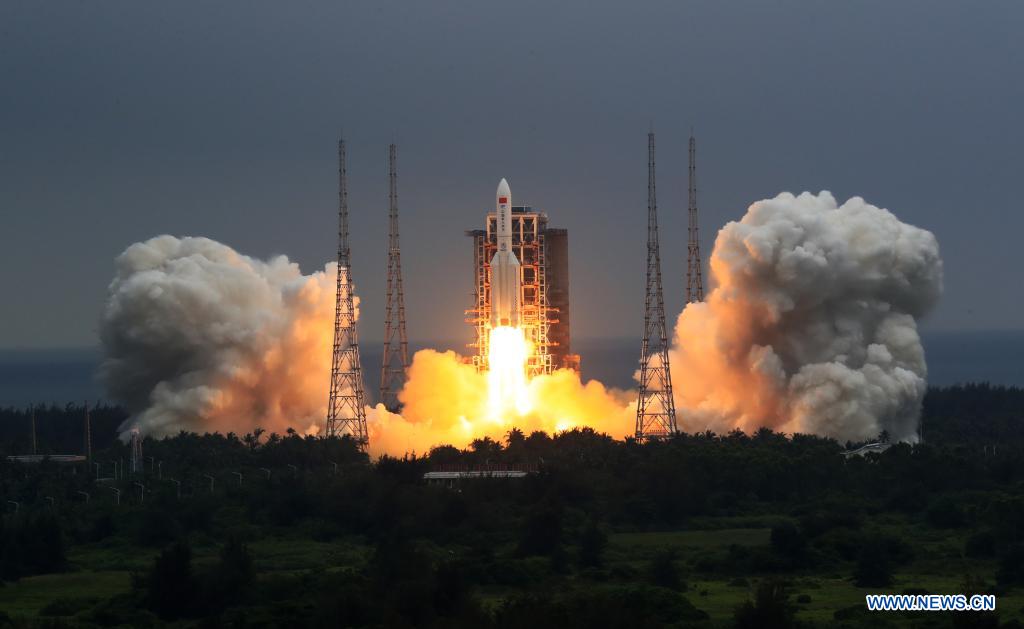China launches space station core module Tianhe
China on Thursday sent into space the core module of its space station, kicking off a series of key launch missions that aim to complete the construction of the station by the end of next year.
China on Thursday sent into space the core module of its space station, kicking off a series of key launch missions that aim to complete the construction of the station by the end of next year.
The Long March-5B Y2 rocket, carrying the Tianhe module, blasts off from the Wenchang Spacecraft Launch Site in south China's Hainan Province, April 29, 2021. China on Thursday sent into space the core module of its space station, kicking off a series of key launch missions that aim to complete the construction of the station by the end of next year. (Xinhua/Ju Zhenhua)
The Long March-5B Y2 rocket, carrying the Tianhe module, blasted off from the Wenchang Spacecraft Launch Site on the coast of the southern island province of Hainan.
Tianhe will act as the management and control hub of the space station Tiangong, meaning Heavenly Palace, with a node that could dock with up to three spacecraft at a time for short stays, or two for long, said Bai Linhou, deputy chief designer of the space station at the China Academy of Space Technology (CAST), under the China Aerospace Science and Technology Corporation.
Tianhe has a total length of 16.6 meters, a maximum diameter of 4.2 meters and a takeoff mass of 22.5 tonnes, and is the largest spacecraft developed by China.
The space station will be a T shape with the core module at the center and a lab capsule on each side. Each module will be over 20 tonnes. When the station docks with both manned and cargo spacecraft, its weight could reach nearly 100 tonnes.
The station will operate in the low-Earth orbit at an altitude from 340 km to 450 km. It has a designed lifespan of 10 years, but experts believe it could last more than 15 years with appropriate maintenance and repairs.
"We will learn how to assemble, operate and maintain large spacecraft in orbit, and we aim to build Tiangong into a state-level space lab supporting the long stay of astronauts and large-scale scientific, technological and application experiments," said Bai.
"The station is also expected to contribute to the peaceful development and utilization of space resources through international cooperation, as well as to enrich technologies and experience for China's future explorations into deeper space," Bai said.
As the foundation of the station, Tianhe will help China's aerospace engineers carry out the verification of key technologies, including flexible solar wings, in-orbit assembly and maintenance, and above all a new life support system.
China will also send the Tianzhou-2 cargo spacecraft and Shenzhou-12 manned craft this year to dock with the core module. Three astronauts will be aboard Shenzhou-12 and stay in orbit for three months, said Hao Chun, director of the China Manned Space Agency (CMSA).
"We will transport support materials, necessary spare parts and equipment first, and then our crew," said Hao.
Tianzhou-3 cargo craft and Shenzhou-13 manned spaceship will also be launched later this year to dock with Tianhe, and another three astronauts will then begin their six-month stay in orbit.
The longest stay in space so far by Chinese astronauts is 33 days. "In previous missions, we sent water and oxygen to space along with astronauts. But for a stay of three to six months, water and oxygen would stuff the cargo craft full with no room for other necessary goods and materials. So we installed the core module with a new life support system to recycle urine, exhaled breath condensate (EBC) and carbon dioxide," said Bai.
After the five launch missions this year, China plans six missions, including the launch of the Wentian and Mengtian lab modules, two cargo spacecraft and two manned spaceships, in 2022 to complete the construction of the space station.
"We have to make sure every launch is reliable and operation of spacecraft in orbit is safe and sound. Every mission is a test for our organization, management, technology and support ability," said Zhou Jianping, chief designer of China's manned space program.


